The best mountain bike disc brakes will help you go faster. Sound like an oxymoron? Maybe, but it’s true.
The fact is, if you know you can quickly and efficiently bring your speed under control, you’re more likely to let it creep up into the red zone. Consequently, you become a faster and more controlled rider.
Some brakes come with four pistons in the caliper and others with two pistons. Four pistons offer more braking power but can increase weight.
Practically speaking, you want stoppers with low maintenance requirements, which hydraulic units generally bring (save for the occasional brake bleed), and easy swapping out of brake pads when the time comes.
We have split the brakes in this list into three categories, based on price. The budget picks in this list all cost under £115 and deliver good entry-level performance at a price point that doesn't break the bank. Our best mid-range picks cost below £215 and offer outstanding value for money. If money is no object and you want the most high-end stoppers on the market, check out our premium picks.
We've included our buyer's guide to mountain bike disc brakes at the bottom of the article, which you should check out if you're considering upgrading your stoppers.
Editor's note: we updated our best mountain bike disc brakes list on 28 March 2025, splitting the selections into price points. We've also added our latest top-rated brakes and removed those that are no longer available.
| Best budget MTB brake | Shimano BL-MT501/MT502 |
| Best mid-range MTB brake | Clarks CRS C4 |
| Best premium MTB brake | SRAM Code RSC |
The best mountain bike disc brakes, as rated by our expert testers
Best budget brakes – top picks under £115
Shimano BL-MT501/MT502
SQUIRREL_TEXT_13083948
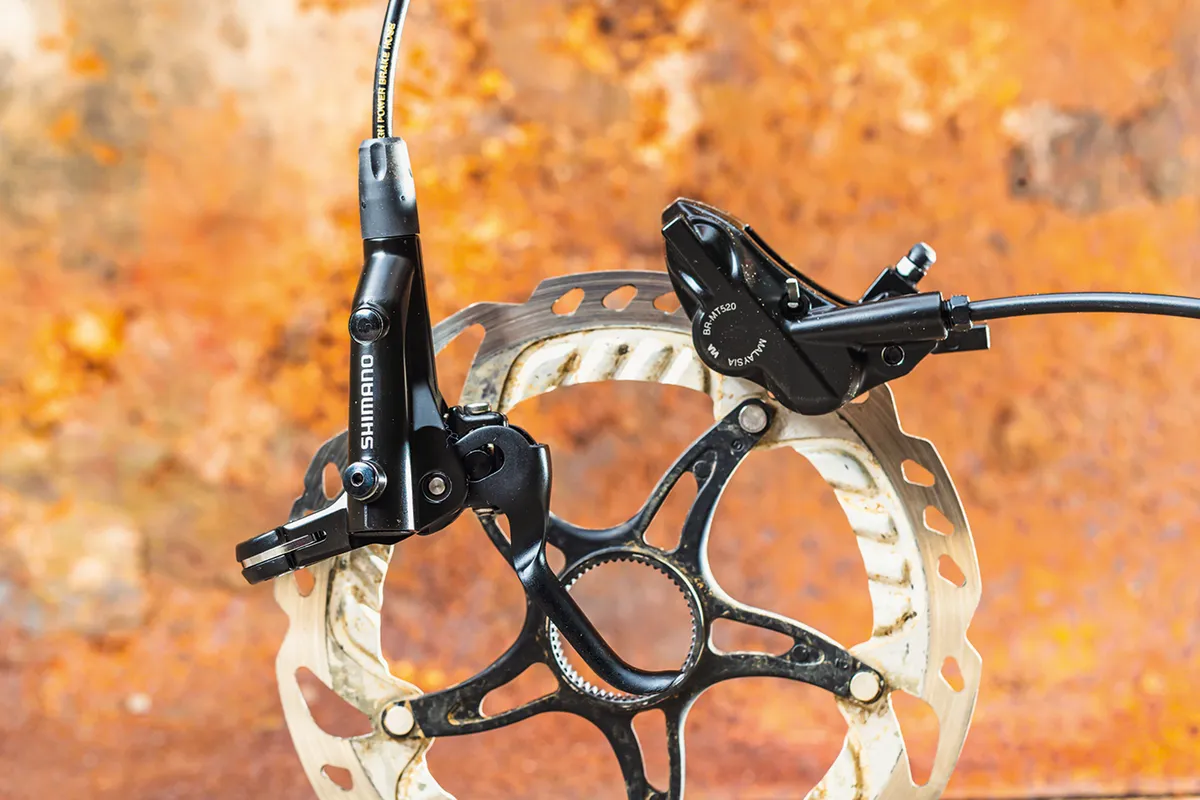
- £100 / $145 / €132 as tested
- Pros: Easy and controllable power; well priced; spares are easy to find
- Cons: Some quirks can be annoying
The Shimano BL-MT501/MT502 brakes may cost half the price of some more premium hydraulic mountain bike brakes, but this doesn't stop them from performing remarkably well.
A hinged clamp makes attaching the brakes to your handlebars easy and that's a great feature at this price point.
The left/right-specific levers also get Shimano's ServoWave linkage, which means the early part of the lever's stroke pushes the pads in further than the later stroke. This helps give plenty of control and also enables Shimano to create more space between the pads and disc brake rotors – ideal for mucky conditions.
The pads are held in place with a split pin, which is easier to produce but potentially makes for fiddlier pad changes.
The tubes come out of the brakes at a fixed angle and the tubing for the rear brake is 1,700mm, which might not be long enough for the most progressive downhill or enduro bikes.
Despite a few minor quirks, it's hard to fault these four-pot brakes from Shimano. They bring plenty of stopping power and have a crisp, positive lever feel.
Specs
Pistons: Four | Fluid: Mineral oil | Weight: 297g (front), 315g (rear) | Adjustments: Reach (TD)
SQUIRREL_13083948
Clarks Clout 1
SQUIRREL_TEXT_13116648
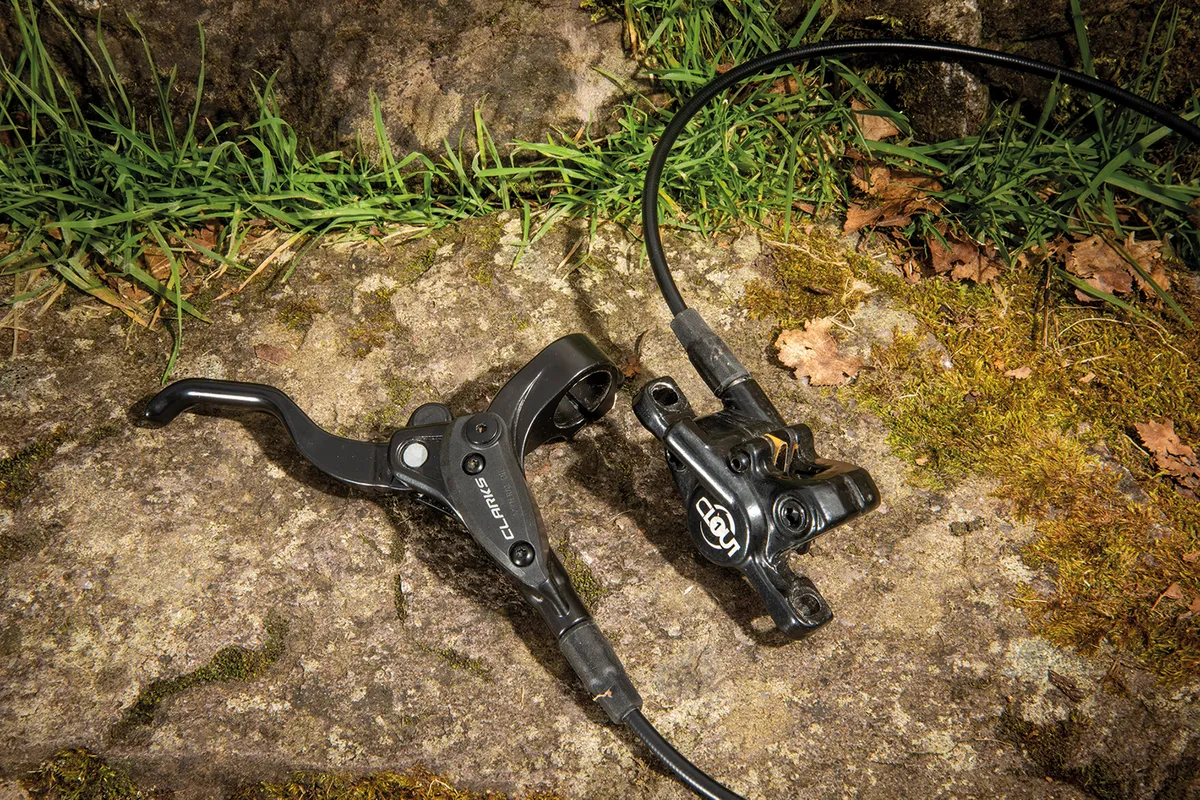
- £25 inc. rotor as tested
- Pros: Incredible value; comes with rotors; good upgrade from cable disc brake
- Cons: Not the punchiest
Hats off to Clarks for producing an effective hydraulic disc brake for £24.99, or even less if you buy two (£44.99). That price includes a 160mm or 180mm rotor.
It even comes with an olive and barb for trimming the hose (the front hose was already too short for our longer-travel trail bikes, but that’s not the sort of use this is really designed for). Because the bar clamp isn’t hinged, you need to slide the grip off, but the lever fits easily and has a solid feel for the price.
While lacking in bite and power relative to more expensive models, the Clout works fairly well. If you’re upgrading a basic bike from cheap cable-operated discs, it’ll be far ahead of what you have. Don’t expect aggressive performance, but for the price it’s outstanding.
Specs
Pistons: Two | Fluid: Mineral oil | Weight: 304g | Adjustments: Reach (TD)
SQUIRREL_13116648
Formula Cura
SQUIRREL_TEXT_13195860
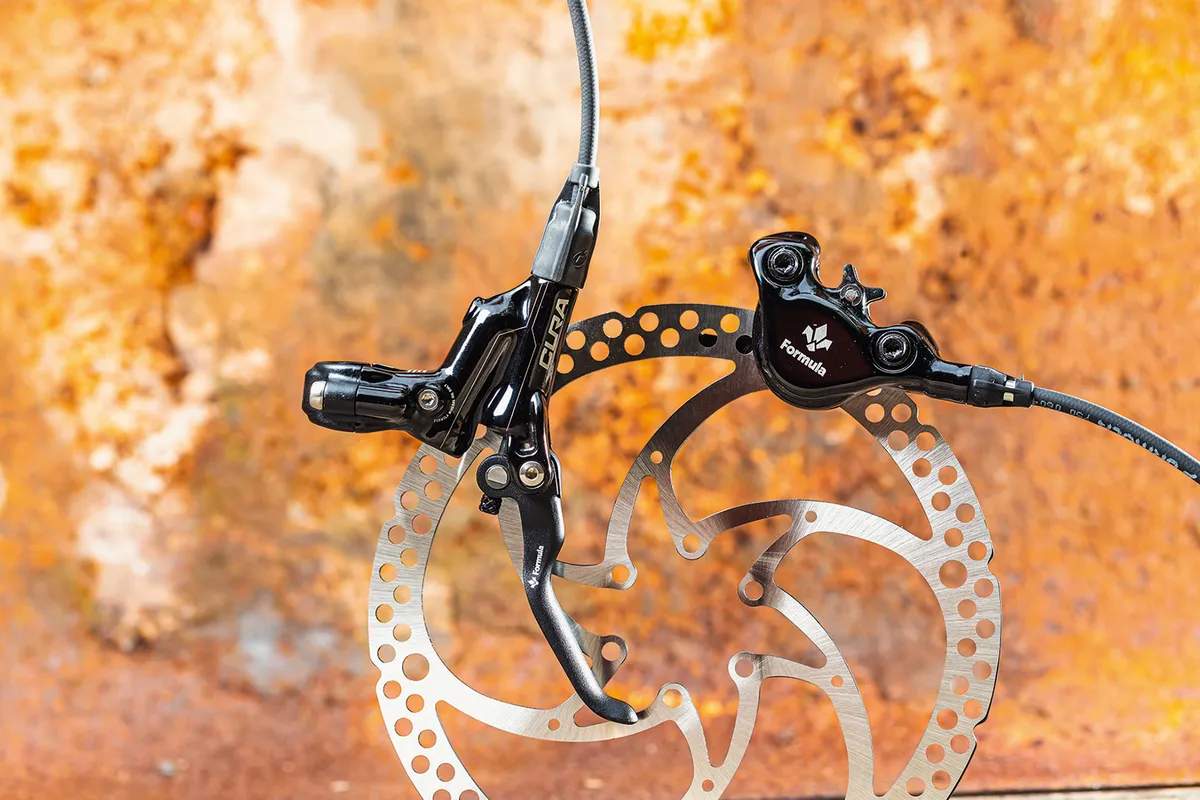
- £114 / €124 as tested
- Pros: Light lever feel; good modulation; lightweight
- Cons: Can be fiddly to set up
The Formula Cura is a classy-looking two-piston brake that's well suited to light and fast trail mountain bikes and downcountry bikes.
The lever has a flip-flop design, so it can be used as a lever for either a front or rear brake. It has a split clamp to attach it to the bar with a nice finish, like the whole of the brake.
Long 2,000mm hoses should provide enough length for the largest of bikes and these attach to the calipers at fixed points.
When it comes to performance, the well-shaped levers have a light, soft feel with little effort needed to squeeze them, and while braking force isn't up to that of the most powerful four-piston brakes, there's still plenty of clamping force from the large 24mm pistons.
Lever setup and lack of lever adjustment are sticking points, but ultimately these are good-looking and great-performing brakes.
Specs
Pistons: Two | Fluid: Mineral oil | Weight: 239g (front), 251g (rear) | Adjustments: Reach (TF/TD)
SQUIRREL_13195860
Magura MT5
SQUIRREL_TEXT_13136615
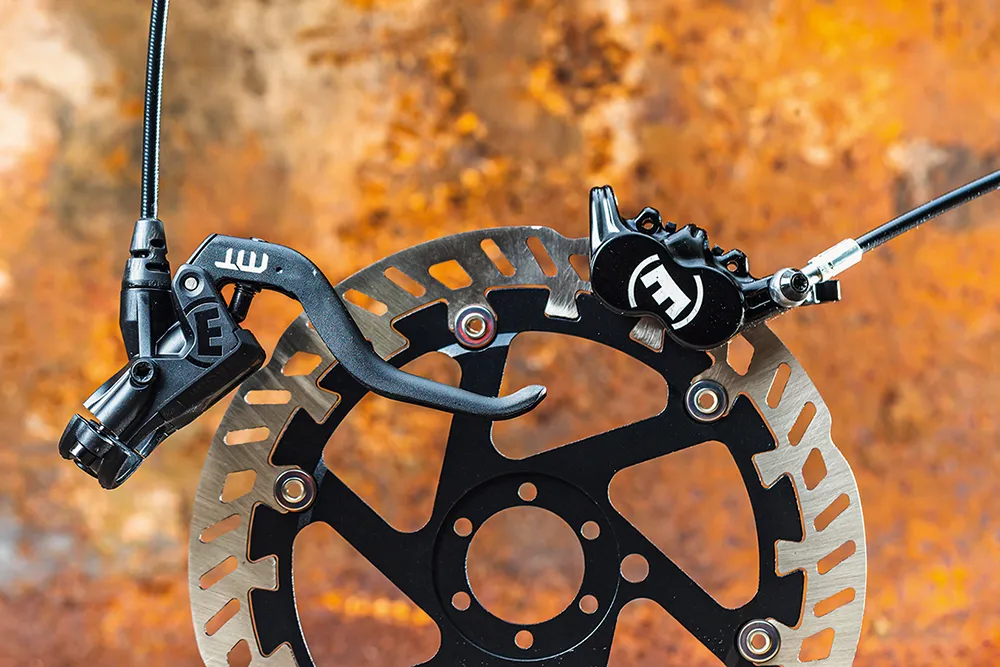
- £95 / $139 / €110 as tested
- Pros: Heaps of power with good modulation
- Cons: Lever feels cheap compared to competition
Built for gravity-orientated and electric bikes, these four-piston Magura MT5 brakes provide heaps of power and easy modulation.
In the caliper, the four pistons press onto one pad, and once bedded in, this system provides plenty of grunt, particularly towards the end of the brake stroke, which is perfect for riding on steep terrain.
Magura offers a range of levers with these brakes and in testing we had the two-finger levers, which exhibited a plasticky feel and flexed slightly.
The brakes had a spongier feel than others, but this could be down to the extra length and flex at the lever. This might not seem ideal, but it does allow you to feather speed when you're going fast.
When it comes to maintenance, bleeding the brakes is easy and the long hoses should fit almost all bikes. Changing the pads requires removing the wheel and there is a knack to it.
Overall, the MT5s pack a punch when it comes to power and won't make a huge dent in your wallet, but costs clearly have been saved with the lever.
Specs
Pistons: Four | Fluid: Mineral oil | Weight: 250g (front), 265g (rear) | Adjustments: Reach (TD)
SQUIRREL_13136615
Best mid-range brakes – top picks under £215
Clarks CRS C4
SQUIRREL_TEXT_13150629
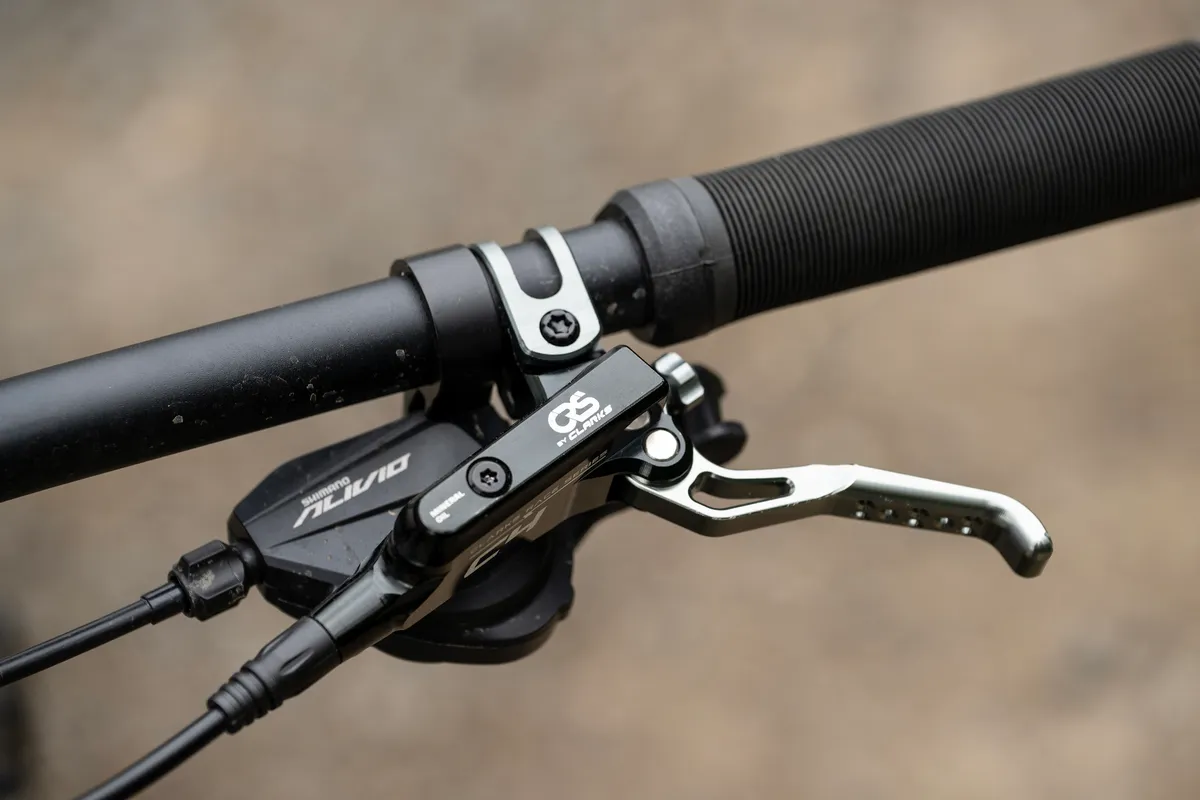
- £199.99 as tested
- Pros: Great value for money; well-specced features; decent modulation
- Cons: Anodised coating is quick to wear
Clarks' CRS C4 brakes are the brand's top-of-the-line stoppers, providing powerful braking and plenty of performance.
The brakes combine high-end looks featuring a Hope-esque caliper with good value, with a brake set including floating aluminium rotors priced at £199.99.
Our tester liked the brake feel and found the levers easy to set up and adjust.
We found the black anodised finish was quick to chip, leading to the aluminium below being exposed.
Specs
Pistons: Four | Fluid: Mineral oil | Weight: 254g (rear) | Adjustments: Reach (TF)
SQUIRREL_13150629
Formula Cura 4
SQUIRREL_TEXT_13195859
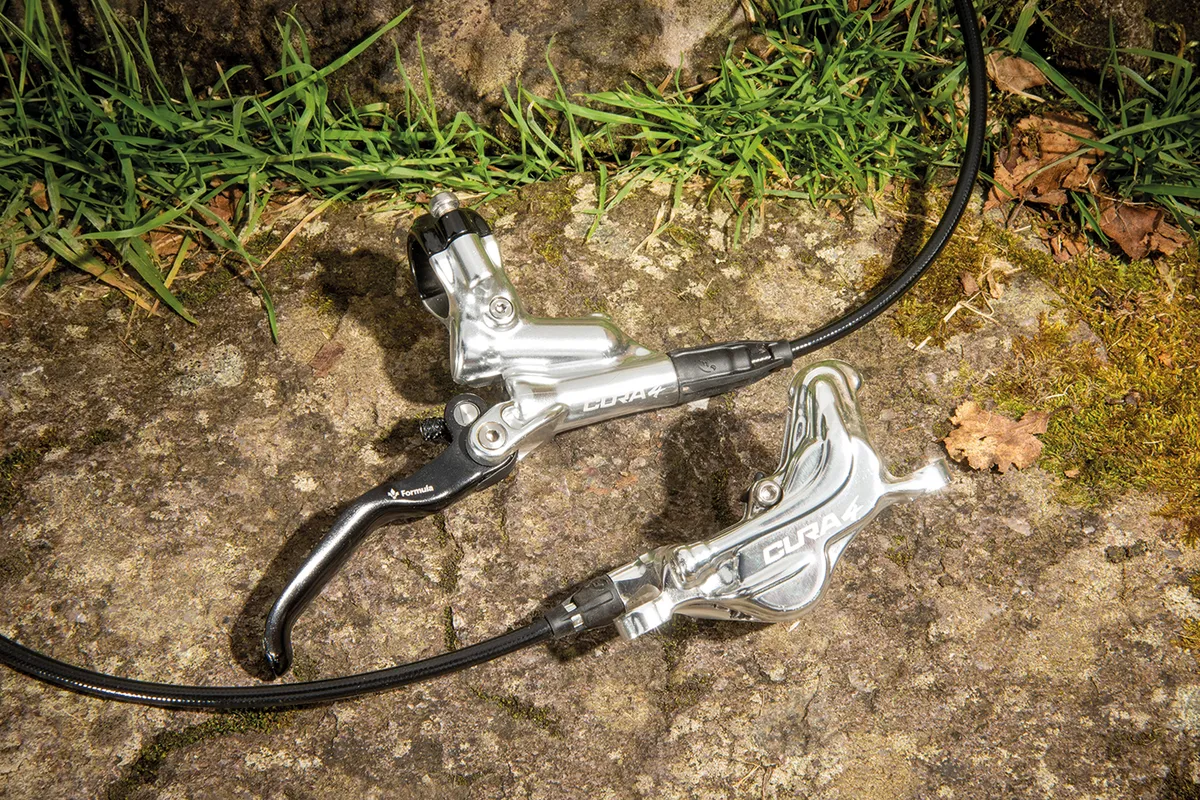
- £150 / AU$295 as tested
- Pros: Easily controlled power; easy to install; impressive lever feel
- Cons: Can be fiddly to bleed
Without much experience of Formula brakes in recent years, we tried the Cura 4 with no expectations. Fitting and bleeding were slightly fiddly, with tight pad clearances making a rub-free result hard to achieve. The fixed hose angle at the caliper meant hose routing was a bit untidy, but once resolved (or accepted) we really liked the sleek lever and caliper. The weight is good too.
There’s power in spades, but the smooth, progressive way it’s applied is even more impressive, making it easy to achieve that magical ‘just below’ pressure before braking traction.
There’s no bite-point adjustment, but once reach was set (with an Allen key), we didn’t think about it anyway.
Specs
Pistons: Four | Fluid: Mineral oil | Weight: 246g | Adjustments: Reach (TD)
SQUIRREL_13195859
Shimano XT M8120
SQUIRREL_TEXT_13082204
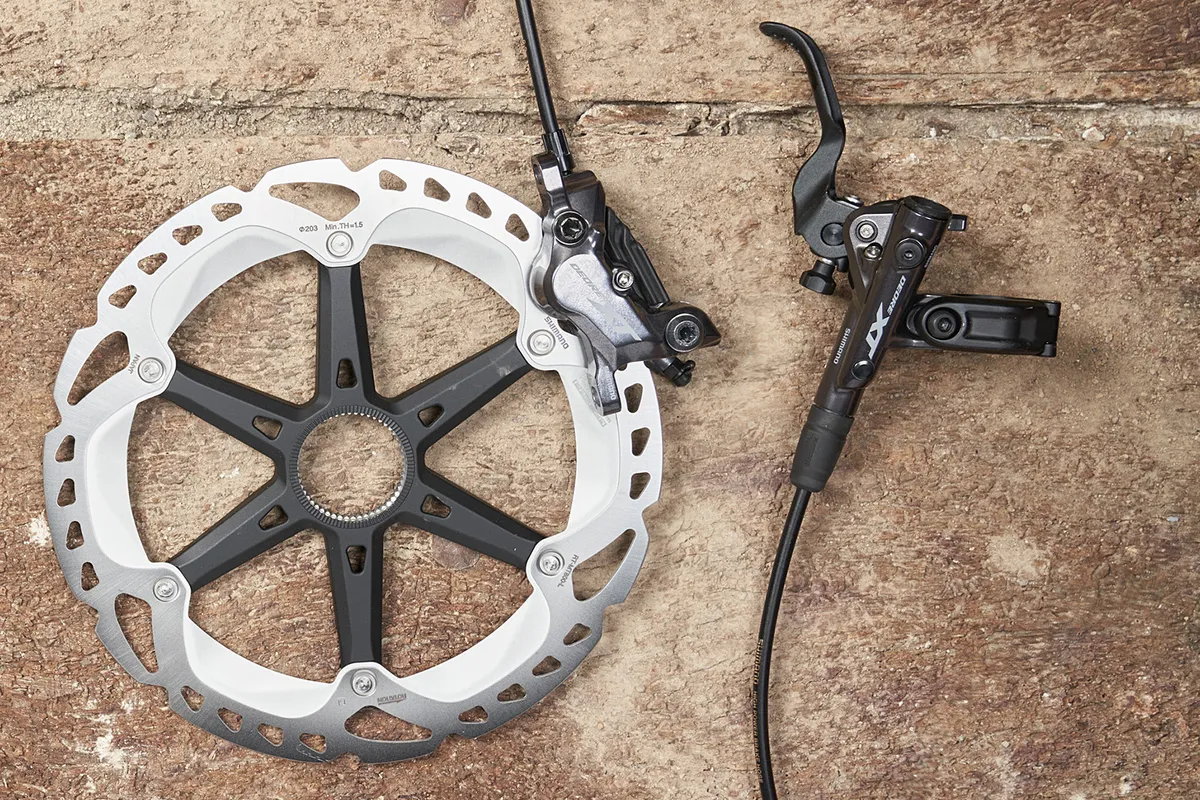
- £200 / $210 / €249.49 / AU$326.99 as tested
- Pros: More than enough power; good lever feel and ergonomics
- Cons: Bleeding process could be easier
The XT M8120s are Shimano's high-end trail brakes and feature all of the best tech found on the flagship XTR model, only using slightly heavier materials.
The initial bite is punchy with a lot of power delivered early, making it easily accessible without having to pull the lever a long way through its rotor-contact stroke.
Hoses arrive unattached, making them easy to route into frames, and only on occasion did we need to re-bleed the brake after cutting the hose.
While we did experience some noise from the rear brake when the heavier-vented pads would occasionally vibrate against the disc, the XT remains a benchmark brake.
Specs
Pistons: Four | Fluid: Mineral oil | Weight: 314g (rear, no rotor) | Adjustments: Reach, bite point
SQUIRREL_13082204
Hayes Dominion A4
SQUIRREL_TEXT_13085971
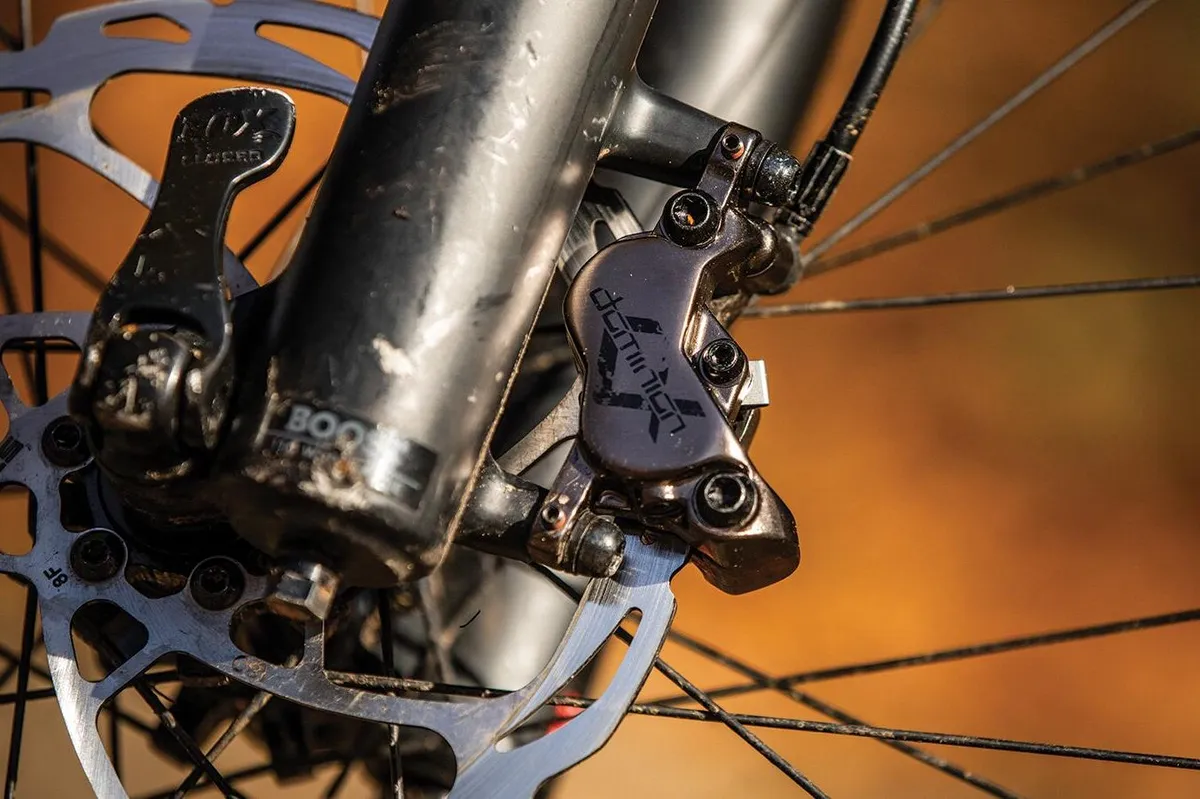
- £200 as tested
- Pros: Easy to install and bleed; plenty of adjustment; quiet; impressive consistency
- Cons: Enough but not incredible power
Hayes dominated the brake scene in the early 2000s before dropping off the radar for a while. It came back with the Hayes Dominion A4, a brake that offers easy bleeding, full adjustability and a consistent lever feel.
Each brake is tuned for prompt and consistent pad engagement. The combination of four large 17mm pistons with semi-metallic pads means braking is progressive rather than sudden.
Elsewhere, Hayes has included two bleed ports. This is a neat feature allowing you to flush bubbles out from either side of the brake block.
You do have to drop the wheel out to change the brake blocks, which is frustrating.
While this is a brake packed full of features, and promises easy setup, it does come with a high price.
Specs
Pistons: Four | Fluid: DOT 5.1 | Weight: 310g | Adjustments: Reach (TF)
SQUIRREL_13085971
Hope Tech 4 V4
SQUIRREL_TEXT_13083943
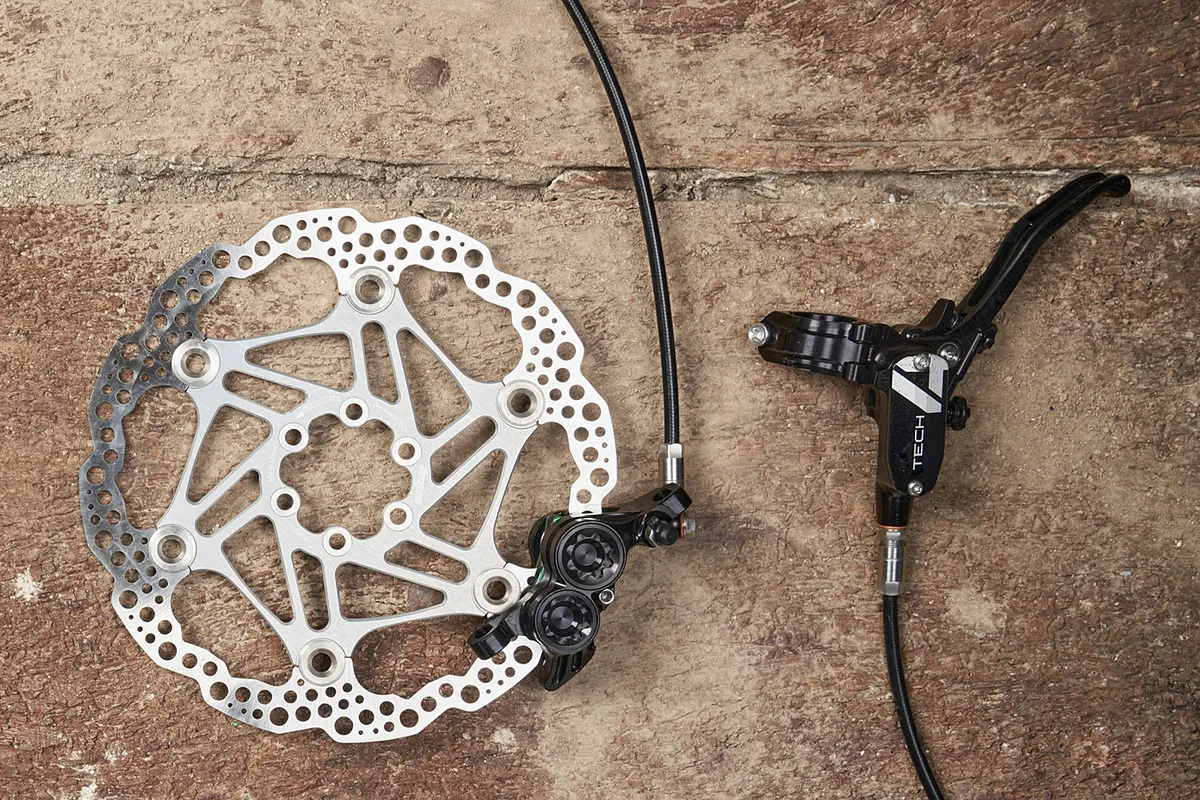
- £210 / $265 / €261.49 / AU$378 as tested
- Pros: Impressive levels of power; lighter lever feel than previous-gen; good build quality
- Cons: Factory bleed can be inconsistent; sharp edges might not be for everyone
The Tech 4 is a marked improvement over the previous-generation Tech 3, continuing to deliver Hope's customary feel with noticeably more power.
We found it necessary to bleed the brakes upon fitting because the two brakes had a different feel. Bleeding is a simple process with a dedicated reservoir top cap, however there was difficulty setting similar bite points for both levers.
The new lever design is claimed to provide 30 per cent more system power, and pulls smother than previously. Quite a lot of pull action was required to access the brakes' full output, which we found quite tiring. If you're a fan of either Hope or Magura brakes' feel, then you'll get on well with the Tech 4s.
Specs
Pistons: Four | Fluid: DOT 5.1 | Weight: 256g (rear no rotor) | Adjustments: Reach (TF), bite point (TF)
SQUIRREL_13083943
Shimano SLX M7120
SQUIRREL_TEXT_13083232
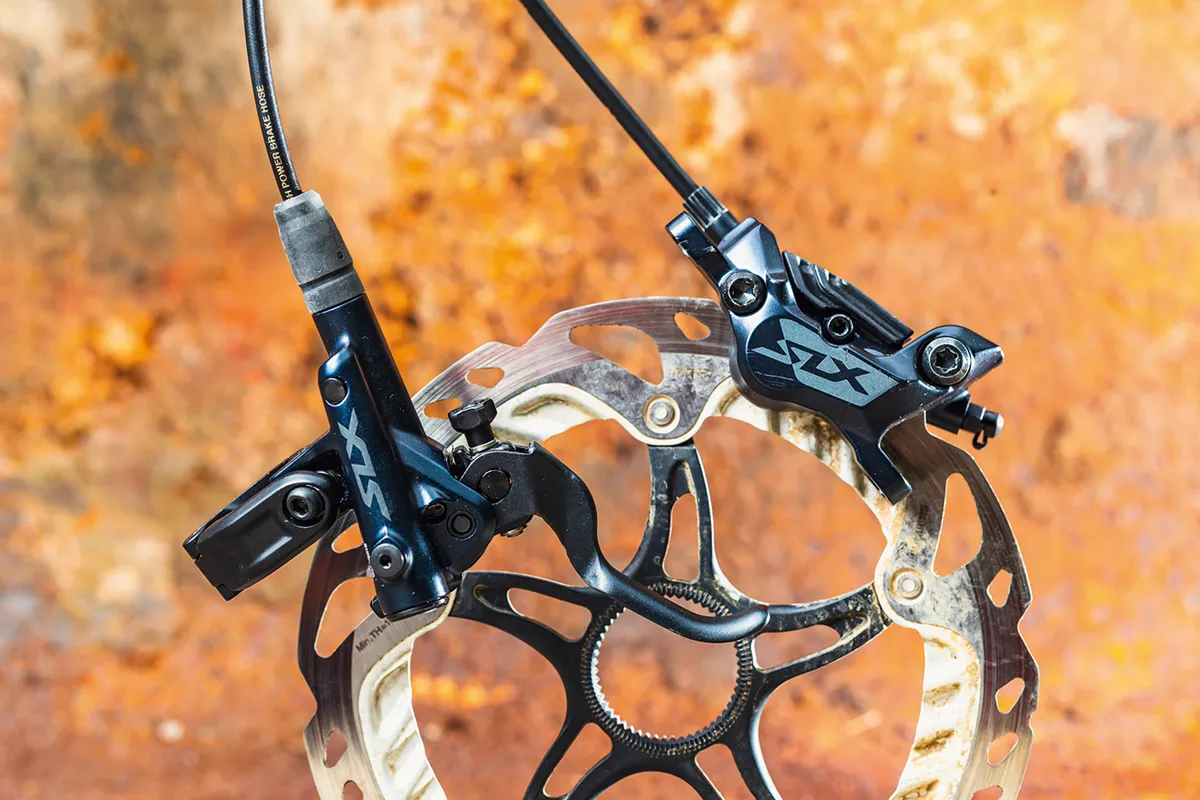
- £160 / $180 as tested
- Pros: Good stopping power; impressive heat management; great lever feel
- Cons: Some won't like direct feel; pads make noise over rough ground
Sitting between the budget Shimano Deore and higher-end Shimano XT groupsets, Shimano SLX is sometimes overlooked. However, SLX has plenty of great features and performs admirably, as these mid-price SLX M7120 brakes prove.
The lever attaches to the bar with a hinged clamp, and although the lever takes up more room than others, the fact it's compatible with Shimano I-Spec mounting options means you can maintain a clean cockpit. The lever itself is 70mm long with no flex, making the brakes feel assured and firm.
The four-piston calipers provide excellent stopping power, even on heavier electric bikes. Pair this with the lever feel and these brakes are super-positive, engaging power almost instantly, and giving that trademark Shimano brake feel.
Arguably, this makes applying power with finesse harder than other brakes, but it does give you plenty of confidence that things are working as they should. However, getting the right bleed is critical to the performance of these brakes.
The SLX M7120 might not have the same functions as Shimano's pricier brakes, notably Free Stroke adjustment, but we didn't miss this a great deal in testing.
Specs
Pistons: Four | Fluid: Mineral oil | Weight: 307g (front), 320g (rear) | Adjustments: Reach (TF)
SQUIRREL_13083232
SRAM Code R brakes
SQUIRREL_TEXT_13101952
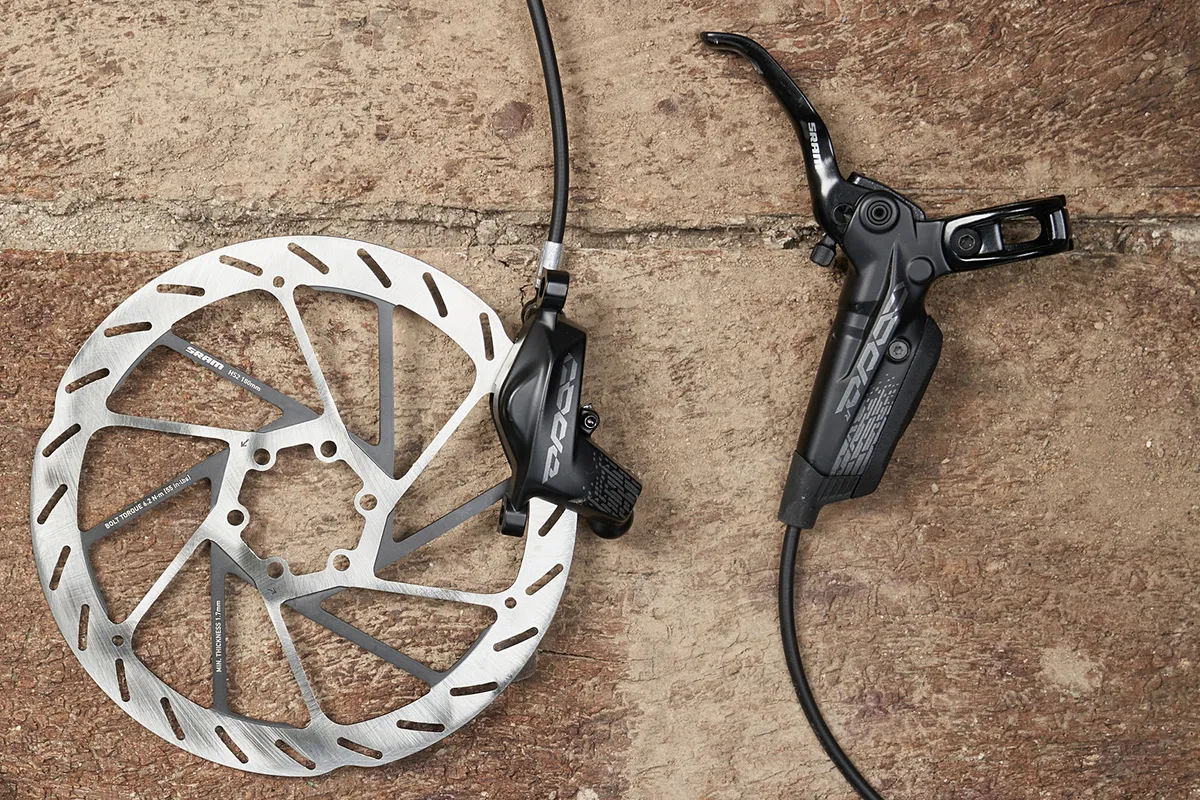
- £155 / $167 / €200.49 as tested
- Pros: Impressive power; easy bleed process; good modulation
- Cons: Need more maintenance than others
The Code R is the entry-level to the more powerful Code line of stoppers and, like all SRAM brakes, attaches using the Matchmaker Clamp enabling easy integration with SRAM shifters and dropper posts.
There's good initial bite without being grabby, and full power can be achieved with the use of one finger. The power curve feels linear, giving a predictability to where the bite is.
These are exceptional brakes given their cost, and there are few better options out there.
Specs
Pistons: Four | Fluid: DOT 5.1 | Weight: 333g (rear no rotor) | Adjustments: Reach
SQUIRREL_13101952
Best premium brakes – the best stoppers money can buy
Formula Cura X
SQUIRREL_TEXT_13150631
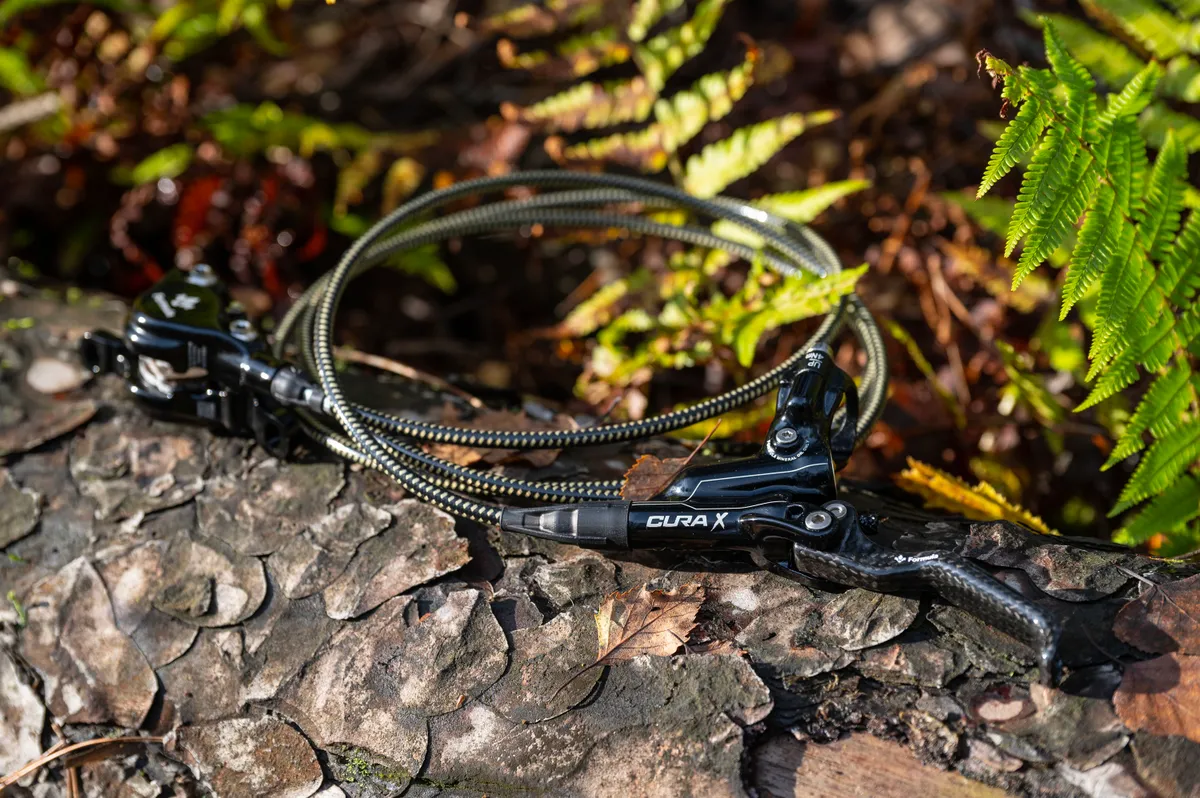
- £249 / $262 / €255 as tested
- Pros: High power levels; progressive lever feel; quality finish
- Cons: Kevlar hose is hard to cut
The Formula Cura X is the brand's top-of-the-range trail-focused disc brake, featuring titanium hardware, a carbon lever and construction that is second to none.
Bleeding the brakes was a simple affair, and once the pads were bedded in, we found the performance impressive considering their weight.
While not as punchy as some enduro brakes, the Cura X packs loads of power when compared to two-piston brakes. They're more akin to SRAM and Magura than the digital feel of Shimano brakes.
The only downsides are the limited adjustability of the MixMaster clamp and the lack of bite-point adjustment, which some may expect at this price.
Specs
Pistons: Two | Fluid: Mineral oil | Weight: 220g (front) | Adjustments: Reach (TD)
SQUIRREL_13150631
SRAM Code RSC
SQUIRREL_TEXT_13115453
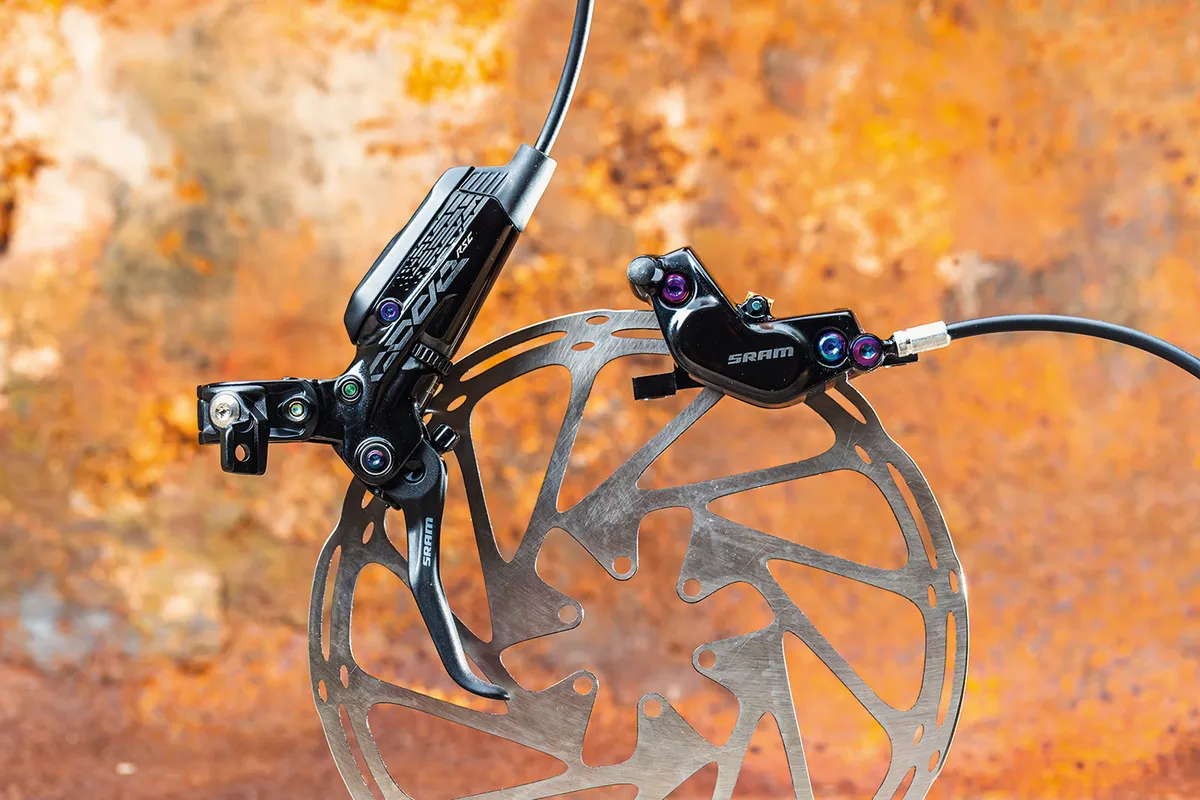
- £230 / $245 / €270 as tested
- Pros: Smooth and consistent power delivery; good power; easy to set up
- Cons: Small resistance in brake lever
The SRAM Code is one of the most popular brakes for downhill and enduro racing, as well as for electric bikes, thanks to its big stopping power. This RSC version is the same as the Code R but provides extra adjustment.
The lever is highly versatile. It can be used on either side of your handlebar and comes with a detachable hinged bar clamp. It also has tool-free adjustment for the lever position and bite point. Inside, a large reservoir helps increase heat resistance.
The lever also provides quick engagement of the pads and eases off the further into the stroke you go for increased modulation.
The caliper is a four-piston design with pads secured via a screw. In testing, we found these helped to deliver as much power as any other option on the market.
Bleeding is easy, even though there might be a few extra steps than with other brakes, and the screw-in barb and screw-on olive make cutting and refitting hoses a straightforward affair.
Overall, these brakes have an excellent feel, top-quality construction and easy maintenance.
Specs
Pistons: Four | Fluid: DOT 5.1 | Weight: 326g (front), 352g (rear) | Adjustments: Reach (TD), bite point (TF)
SQUIRREL_13115453
SRAM Level Ultimate Stealth 4 Piston Brakes
SQUIRREL_TEXT_13090278
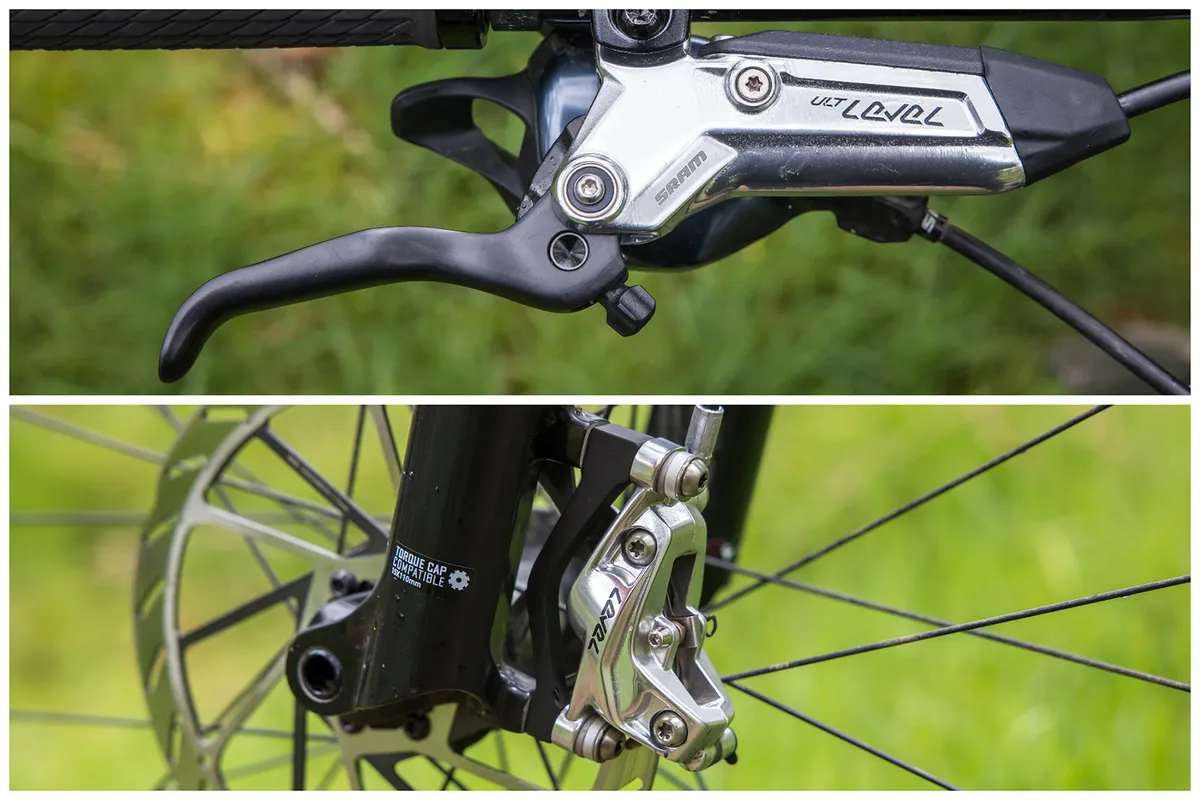
- £320 / $300 / €360 as tested
- Pros: Good modulation and excellent power; easy to bleed; very consistent
- Cons: Expensive; no contact adjustment
SRAM's Level Ultimate Stealth 4 Piston Brakes offer excellent power and modulation at a light weight.
The brakes are versatile, providing reliable stopping power for XC and trail use. The ergonomics have been improved too.
The new design reduced handlebar real estate, which could cause compatibility issues with some handlebar accessories.
Specs
Pistons: Four | Fluid: DOT 5.1 | Weight: 250g | Adjustments: Reach (TF)
SQUIRREL_13090278
SRAM Maven Ultimate
SQUIRREL_TEXT_13116647

- £599 / $599 / €699
- Pros: Incredible amounts of power; easy to fine-tune; good stopping on long descents
- Cons: Pricey; Setup could be easier
SRAM's Maven Ultimate brakes offer impressive stopping power, which results in a punchy feel on the trails.
Even after prolonged descents, the brakes remain consistent with no power lost or wandering bite point.
They are pricey and the setup is more fiddly than other brakes in SRAM's line-up.
But if you're looking for beefy brakes with incredible power, the Mavens should be on your shortlist.
Specs
Pistons: Four | Fluid: Mineral oil | Weight: 362g (claimed) | Adjustments: Reach (TD), bite point (TF)
SQUIRREL_13116647
Hayes Dominion T4
SQUIRREL_TEXT_13134405
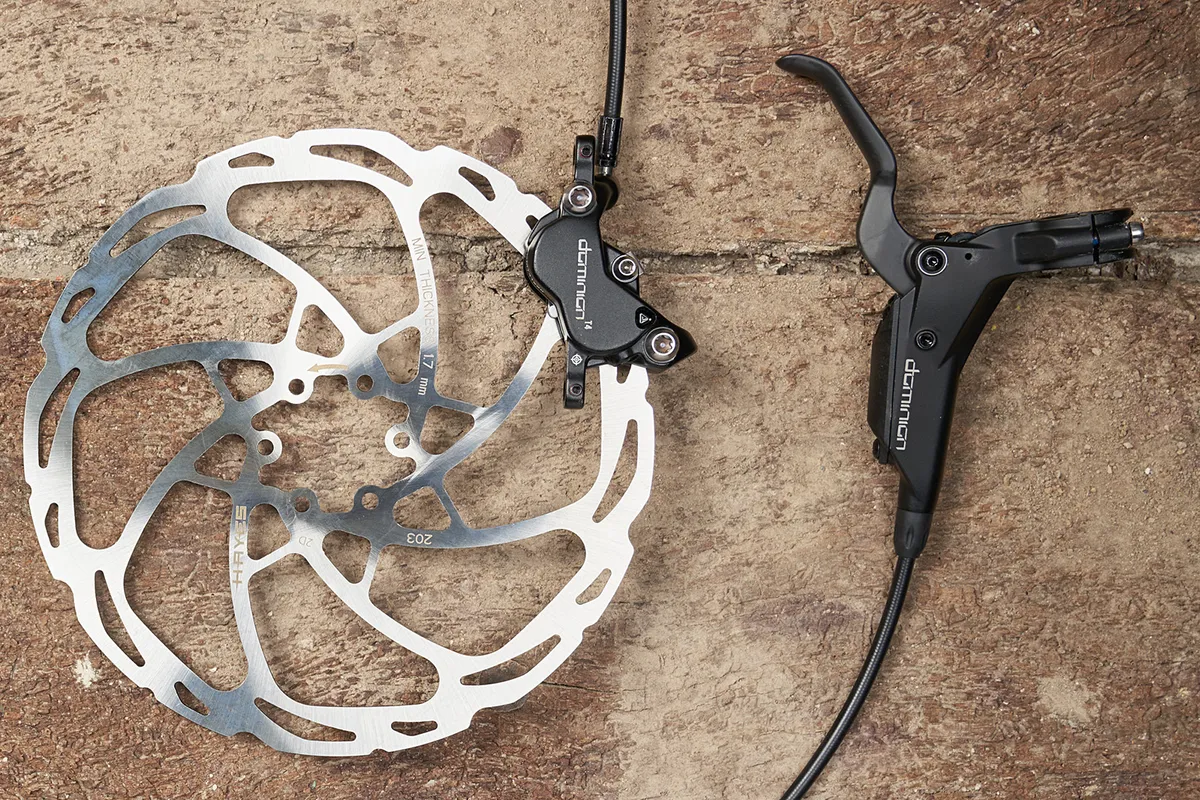
- £340 / $324.99 as tested
- Pros: Competitive weight; easy access to power; innovative caliper design
- Cons: Pricey
The Dominion T4 sheds 40g of weight compared to the Dominion A4, and features a flip-flop design, so it works on either side of the bar. It's easy to mount, with options for SRAM's Matchmaker and I-Spec clamps.
The T4's lever is made from carbon fibre and its smooth finish can be a tad slippery. Reach adjustment is generous, and we measured a 1cm range of bite-point adjustment with the factory bleed.
Power is delivered early in the T4's short stroke, and there's a little softness at the bite that might be a little spongy for some people's tastes. The power on tap impressed with its minimal finger fatigue.
Specs
Pistons: Four | Fluid: DOT 5.1 | Weight: 280g (rear no rotor) | Adjustments: Reach, bite point
SQUIRREL_13134405
Hope XCR Pro X2
SQUIRREL_TEXT_13083395
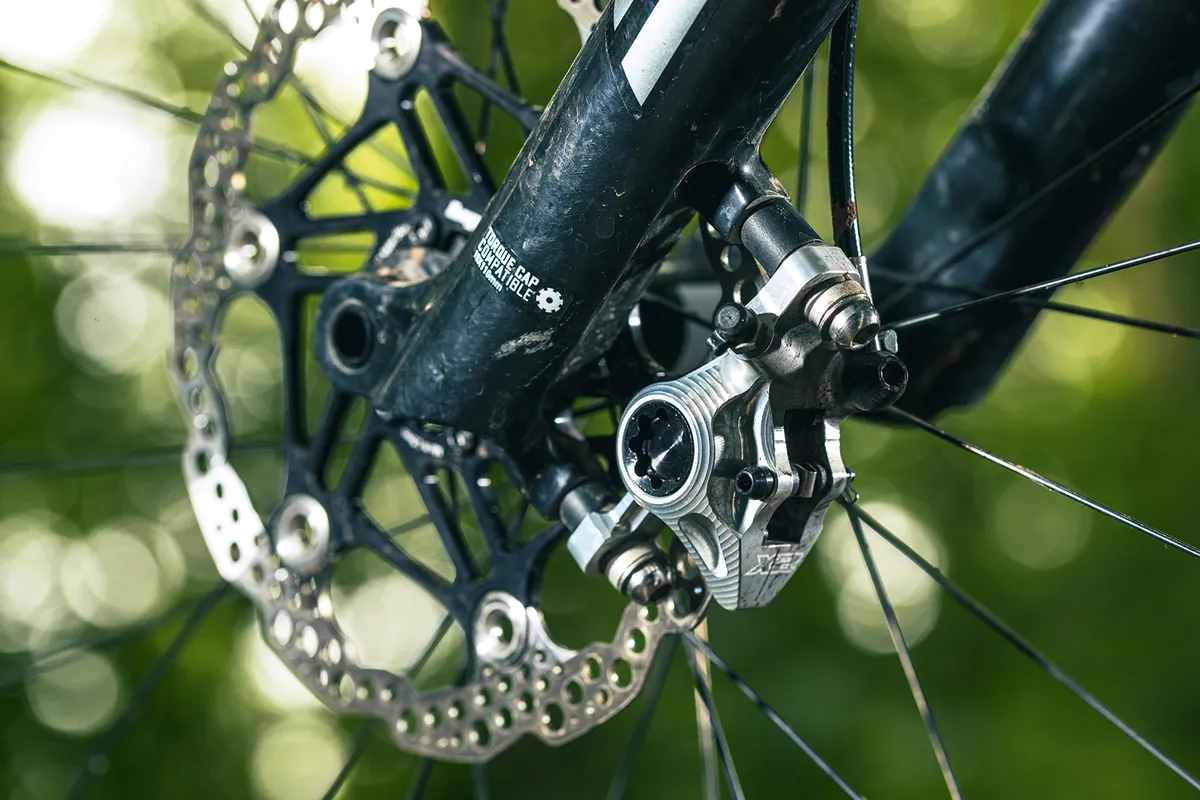
- £250 / $320 / €315 / AU$450 as tested
- Pros: Quality finish; good modulation and lever feel
- Cons: Not the best all-out power; can be noisy in the wet
The Hope XCR Pro X2 cross-country brakes are lightweight with plenty of power, and exhibit Hope's characteristically good build quality and its backup service.
The lever's hinged clamp is compatible with Hope's Tech 3 mounts, so Shimano and SRAM shifters can be attached. The carbon fibre lever blade also has reach adjustment accessed with an Allen key, but doesn't have bite adjustment like some other high-end XC brakes.
The brake has two pistons housed in a CNC-machined caliper. They have a classic Hope feel with less bite than Shimano and less power build-up than SRAM.
While we did notice some squealing in wet conditions, this didn't hamper the stopping performance.
Specs
Pistons: Two | Fluid: DOT 5.1 or DOT 4 | Weight: 213g (rear) | Adjustments: Caliper via an adjustable banjo
SQUIRREL_1308339
Magura MT Trail SL
SQUIRREL_TEXT_13084047
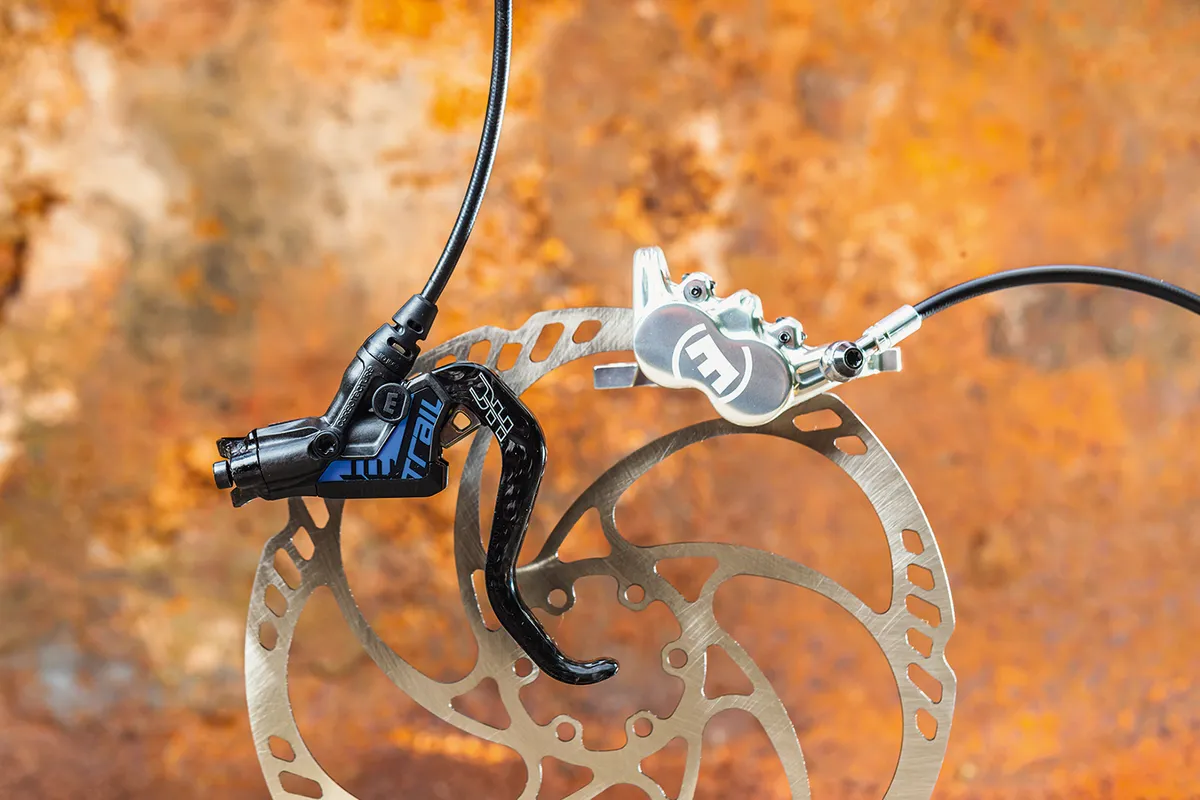
- £497 / $599 / €580 (for pair) as tested
- Pros: Incredible power that is easy to control; lightweight
- Cons: Poor lever feel
The Magura MT Trail SL differs from other trail and enduro brakes by having a four-piston front caliper and a two-piston rear caliper.
The front caliper provides the high braking power and modulation you need for top-level performance, while having fewer pistons on the rear caliper helps save weight. The two pistons on the rear caliper are oversized, so there's still a good chunk of stopping power.
The lever has a flip-flop design and reach adjustment, and Magura offers different lever blade types, which can alter the interface between finger and brake. The single-finger design we tested gave a reasonably sharp initial bite and in the mid-stroke it offered plenty of modulation.
Magura has made the lever body from a material it calls 'carbontecture', which appears to be a carbon-infused composite. This helps the brakes achieve their low weight but at the bar, in general, the construction quality of these brakes doesn't seem to match the price. However, this doesn't stop these brakes from ultimately offering loads of manageable power.
Specs
Pistons: Four front, two rear | Fluid: Mineral oil | Weight: 239g (front), 220g (rear) | Adjustments: Reach (TD)
SQUIRREL_13084047
Shimano XTR M9100
SQUIRREL_TEXT_13084033
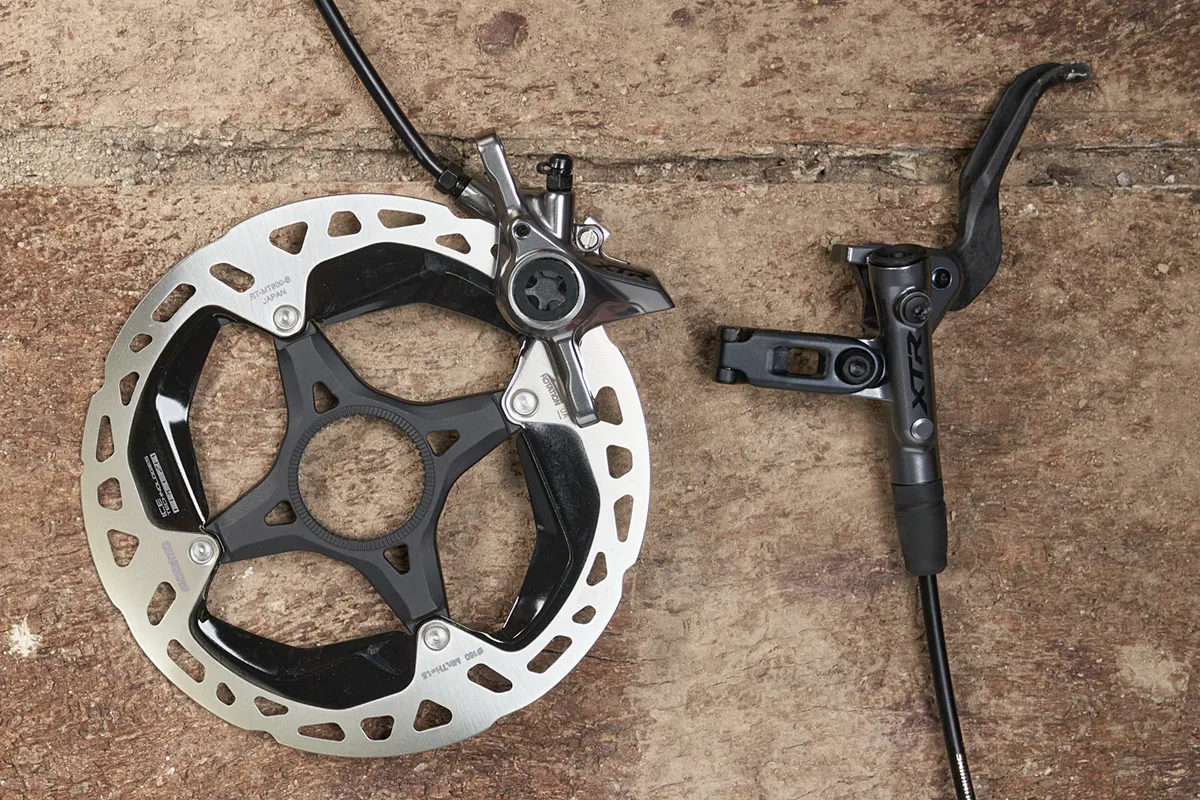
- £235 / $262 / €254.95 as tested
- Pros: Lightweight; good lever feel
- Cons: Not the most powerful; lever can be tricky to install; no free-stroke adjustment
A race-ready XC brake with weight saving as its principle. The XTR M9100 has limited adjustability, with only tooled adjustment for reach via a grub screw on the carbon lever.
The brakes come without hoses attached, making for easy installation, and they didn't need to be re-bled.
Power levels are reasonable, though it is clear that weight savings for XC racing take precedent over all-out power. Full power comes early in the lever stroke, but modulation isn't a problem after a short period of time with the brakes.
The XTR M9100 is one of the best XC brakes on the market, but free-stroke adjustment would add a little more to these race-bred brakes.
Specs
Pistons: Two | Fluid: Mineral oil | Weight: 202g (rear no rotor) | Adjustments: Reach
SQUIRREL_13084033
SRAM G2 Ultimate
SQUIRREL_TEXT_13086213
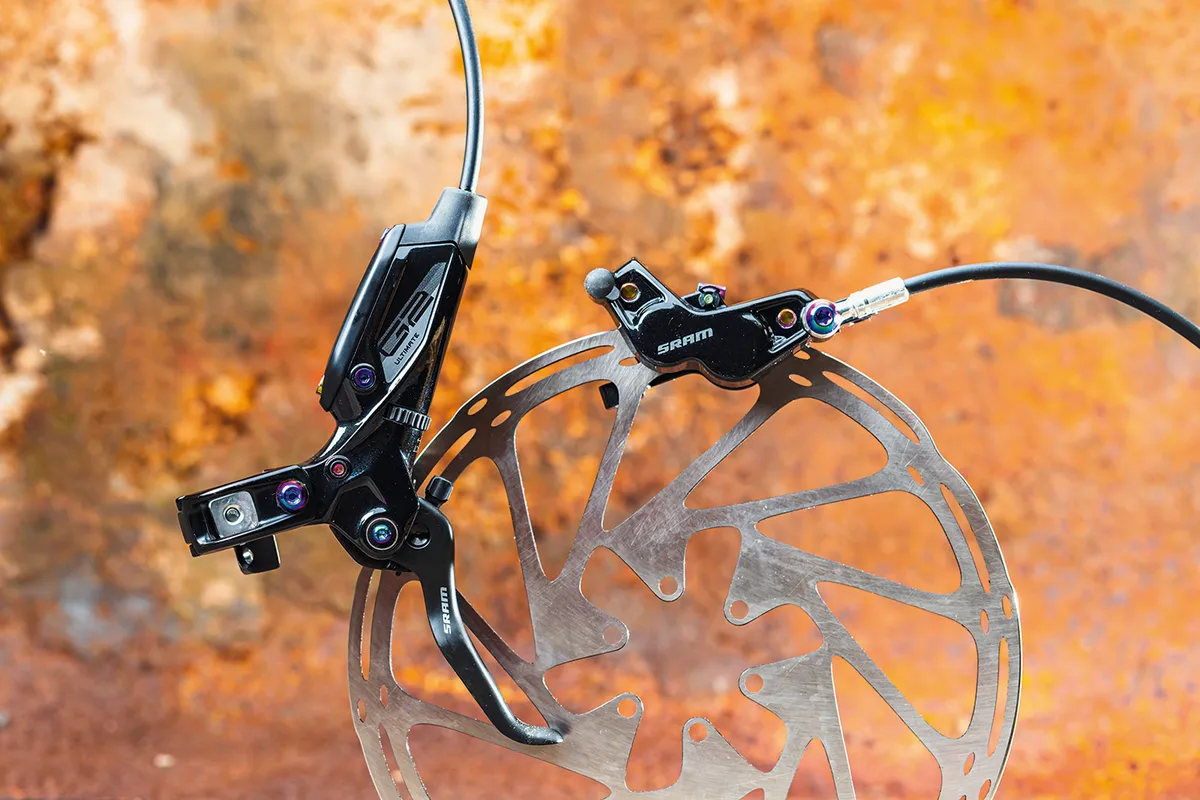
- £265 / $280 / €295 as tested
- Pros: Good lever feel; lever makes for tidy cockpit
- Cons: Power not quite there at the top end
The trail-focused G2 replaces the popular Guide brake in SRAM's line-up and the Ultimate is the top-tier version, with rainbow-coloured hardware, lever pivot bearings and tool-free adjustment.
The 80mm carbon lever has a smooth, contoured shape. The lever provides lots of control, making it easy to correct speed on faster sections or apply a load of stopping power when needed. The action is smooth, but it's a bit more resistant than other brakes.
The four pistons push on a long pad that's held in place with a threaded pin. There's less power than SRAM's Code brakes, but that isn't too much of a surprise considering the small caliper body.
Overall, we found the G2 Ultimate offers a lovely lever action, and while it has ample power it doesn't have quite as much as the best brakes. This might make the premium price tag hard to justify for some, but it might also point to just how good SRAM Code brakes and others truly are.
Specs
Pistons: Four | Fluid: DOT 5.1 | Weight: 281g (front), 290g (rear) | Adjustments: Reach (TF), bite point (TF)
SQUIRREL_13086213
SRAM Level Ultimate
SQUIRREL_TEXT_13086919
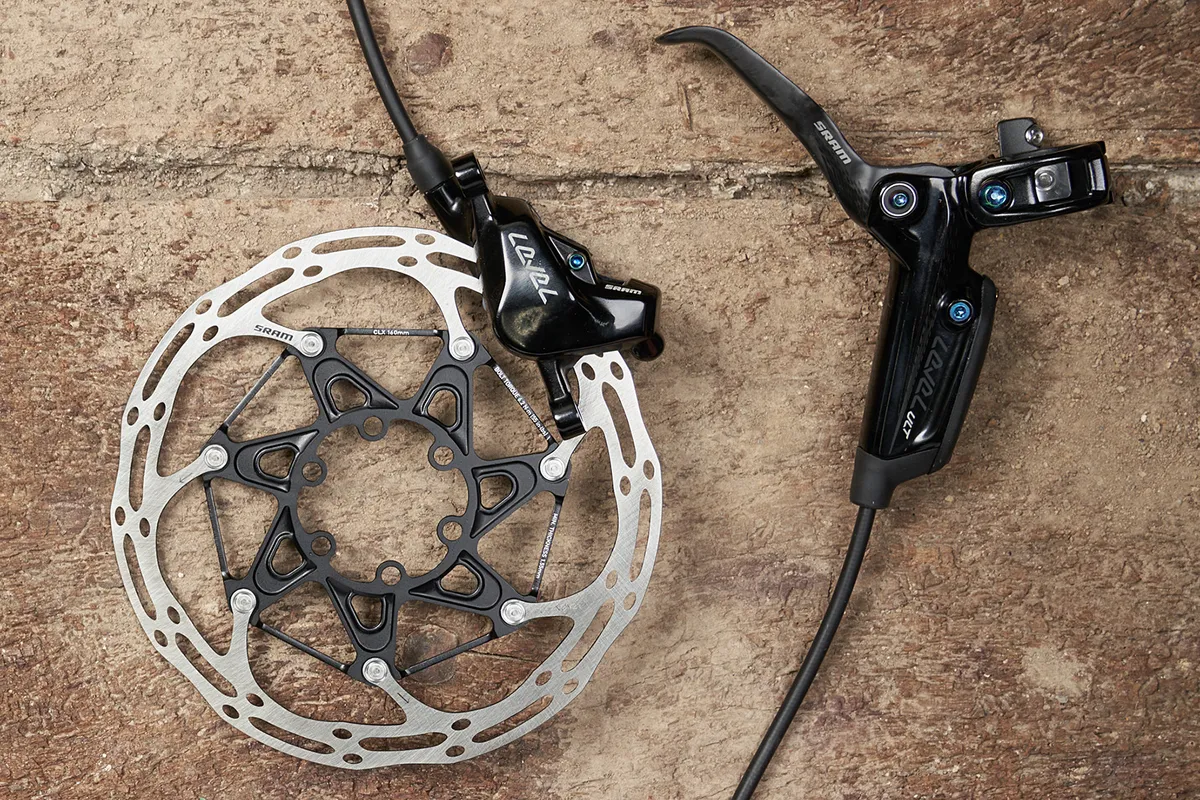
- £276 / $285 / €285.49 as tested
- Pros: Sharp lever feel; high-quality construction
- Cons: Not the most powerful or the lightest
The Level Ultimate is a race-ready XC brake with an emphasis on lightweight design. It uses SRAM's Matchmaker to integrate shifters and dropper levers onto the bars.
The carbon lever is straight and features very little in texture, making it slippery in the wet. A small Allen-headed bolt is required to adjust the lever, and it can be fiddly to adjust. Bite-point adjustment is forgone in the pursuit of weight saving.
Initial bite is snappy and effective with good power levels. Full output is achieved without pulling excessively hard on the levers, preventing excessive arm fatigue.
Specs
Pistons: Two | Fluid: DOT 5.1 | Weight: 248g | Adjustments: Reach
SQUIRREL_13086919
How we test mountain bike disc brakes

We test mountain bike brakes on the trails to see how they perform in their natural habitat.
Our testers run cycles on the brakes to make sure all their strengths and weaknesses are found and to check for longevity.
Ultimately, our mountain bike disc brake reviews are based on the following criteria:
- Power – how well do the brakes stop you?
- Lever feel – how easy are the levers to pull?
- Fading – do the brakes continue to perform when they're hot?
- Ease of maintenance – are the brakes easy to maintain and bleed?
- Adjustability – what kind of adjustability do the brakes have?
- Value for money – are you getting a good deal compared to other brakes on the market?
Why you can trust BikeRadar
BikeRadar has been an authority on bikes and cycling tech since its inception in 2007, delivering the world’s best riding advice.
We have experts testing all types of bikes, parts, clothing and accessories, from road, mountain and gravel bikes to commuting, bikepacking and electric bikes.
Our reviews are always editorially independent – with no exceptions. Our reviewers comprehensively test all products in the real world, always reflecting on performance, value and the wider market when delivering their verdicts and review ratings.
We have more than 15,000 product reviews available at your fingertips, as well as expert buying, maintenance, training, skills, health and fitness advice.
Our annual Bike of the Year test is an industry benchmark and the BikeRadar team consists of some of the most experienced riders and testers in the business.
What to look for when buying mountain bike disc brakes
Rotor size
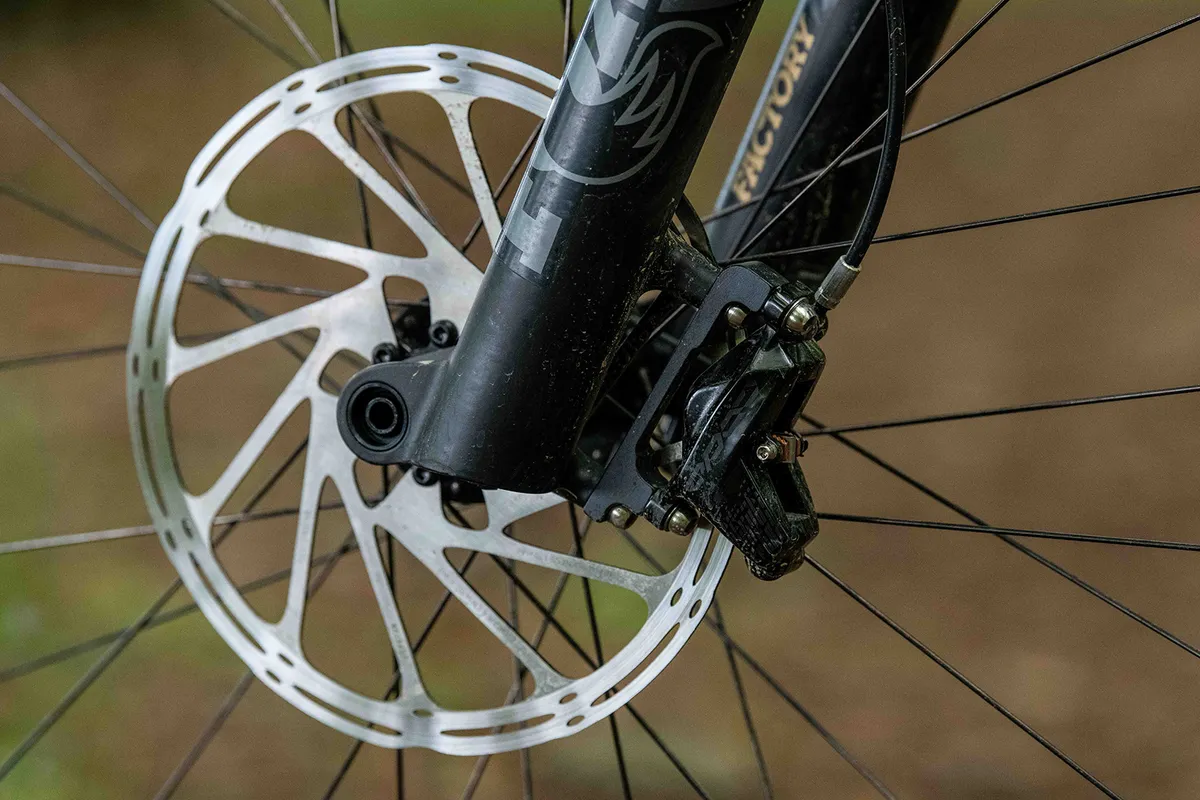
Bigger disc brake rotors exert more force at the tyre and have a larger area to cool down on sustained descents, which keeps them working optimally, but they’re heavier.
You'll often find that the more gravity-orientated a bike is, the larger the rotor size. Cross-country mountain bikes might come with 160mm rotors, trail bikes with 180mm and downhill bikes with 200mm rotors, but rotor sizes extend above the 200mm mark too.
Some riders opt to use a mix of rotor sizes, with a larger rotor on the front for greater braking force and a smaller one on the rear to save weight.
Four-piston brakes vs two-piston brakes
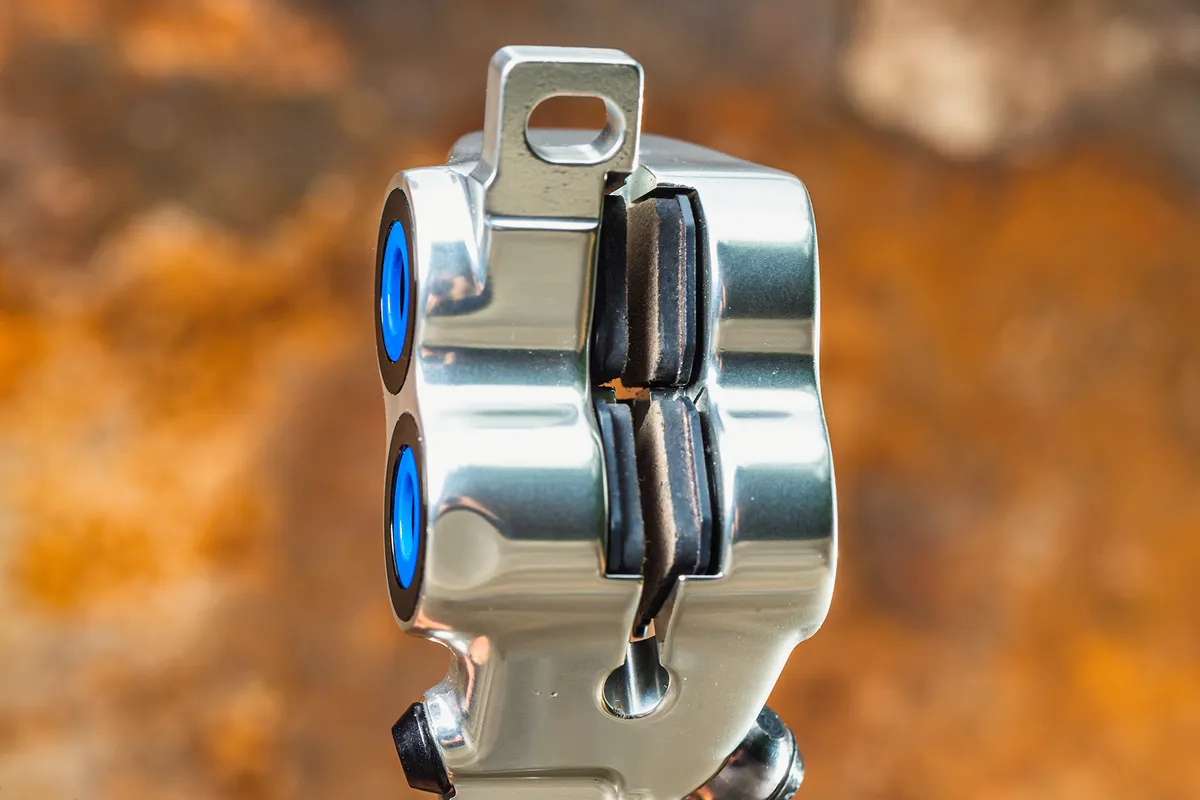
It used to be that only gravity riders would consider four-piston calipers – known as four-pot brakes – and everyone else would stick to two-piston calipers, known as two-pot brakes.
Four pistons deliver more braking force and better heat dissipation, so they’ve steadily crept their way into the mainstream, as trail mountain bikes have become more capable, and the downcountry bike category has boomed.
Of course, two-piston brakes still have acres of power on hand. So don’t write them off if you prefer a simpler setup with fewer pistons to get sticky or malfunction, less weight (although this is marginal) and a lower cost.
Lever adjustment
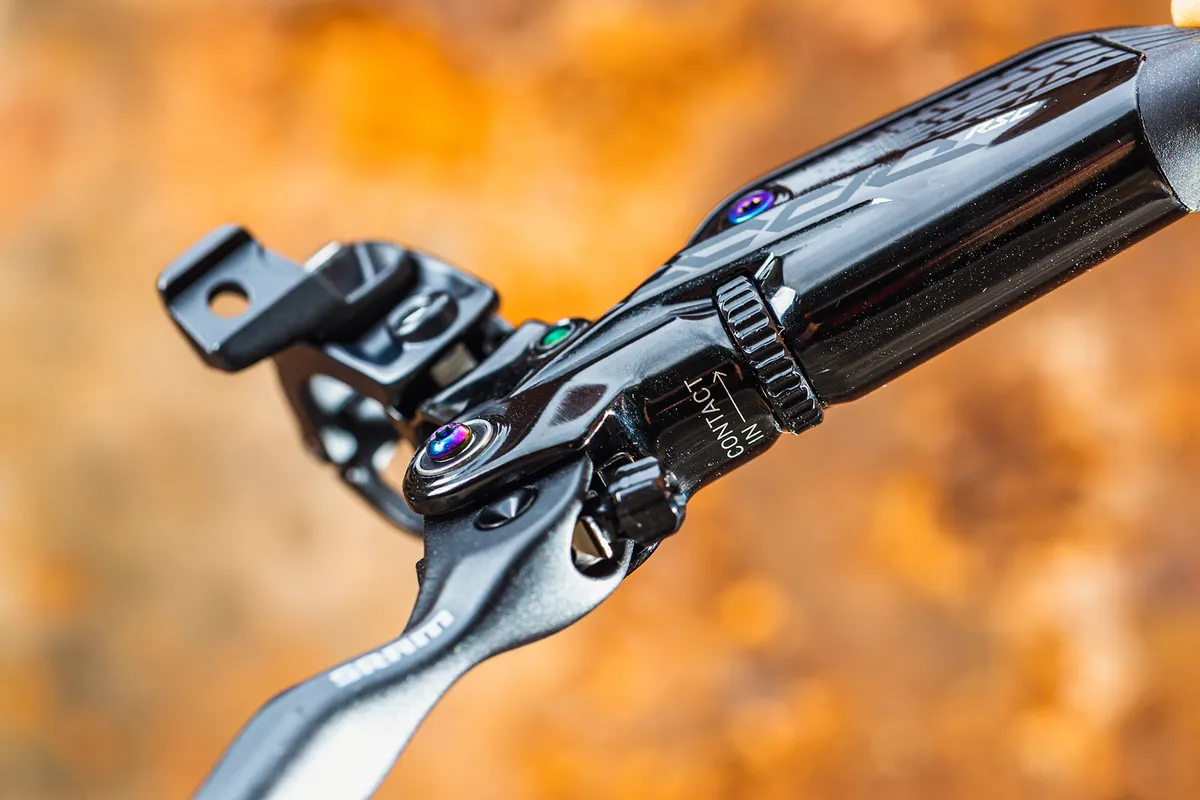
Most brakes offer reach adjustment, which allows you to set the lever distance from the bar to suit your hand size. Some offer bite point (or free stroke) adjustment too, varying the amount of lever-free travel before the pad connects with the rotor. This can be either tool-free or tool-driven.
As you might expect, the more you pay for a set of brakes the more likely it is that they'll have these features.
Brake pad material
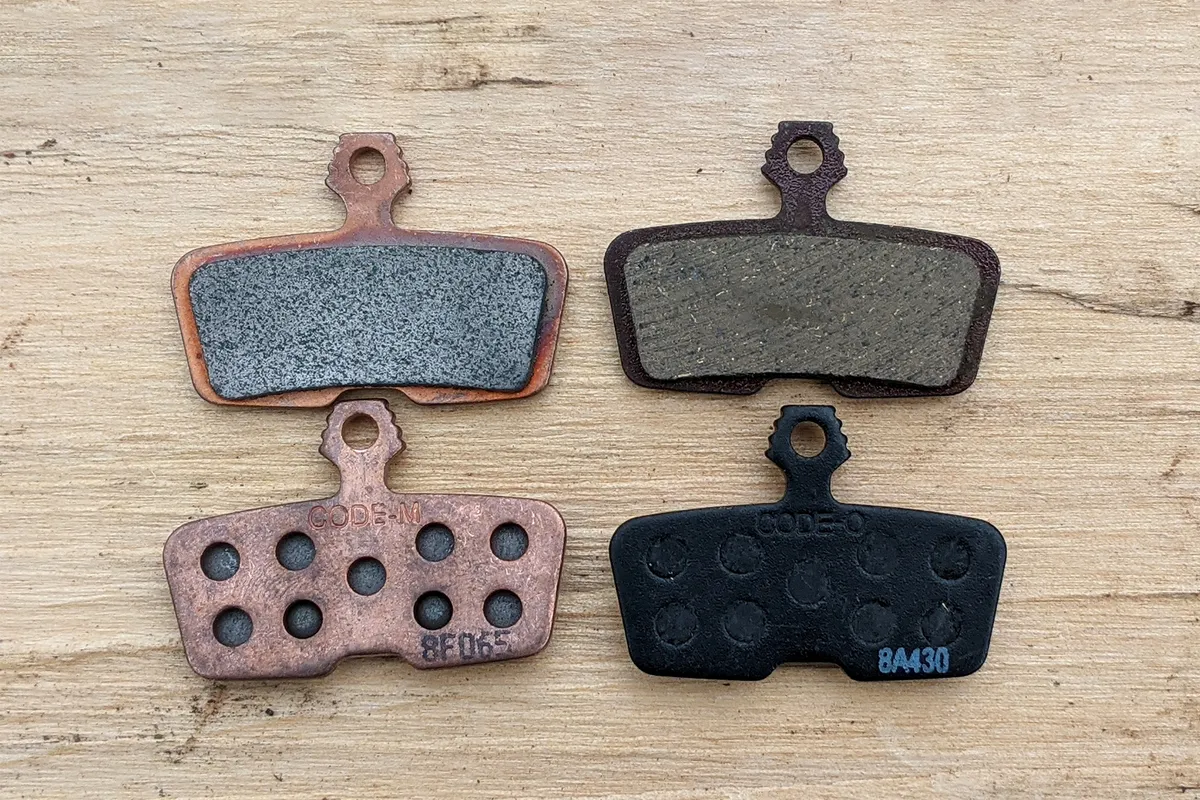
Most disc brake pads are organic pads made of resin, glass, rubber and other non-metallic materials.
They give a good ‘bite’ from cold, but can lose power when overheated and wear quickly.
Sintered pads have more metallic fragments in the compound and can sound harsh, but wear far better and don’t suffer from overheating as much.
Pad removal
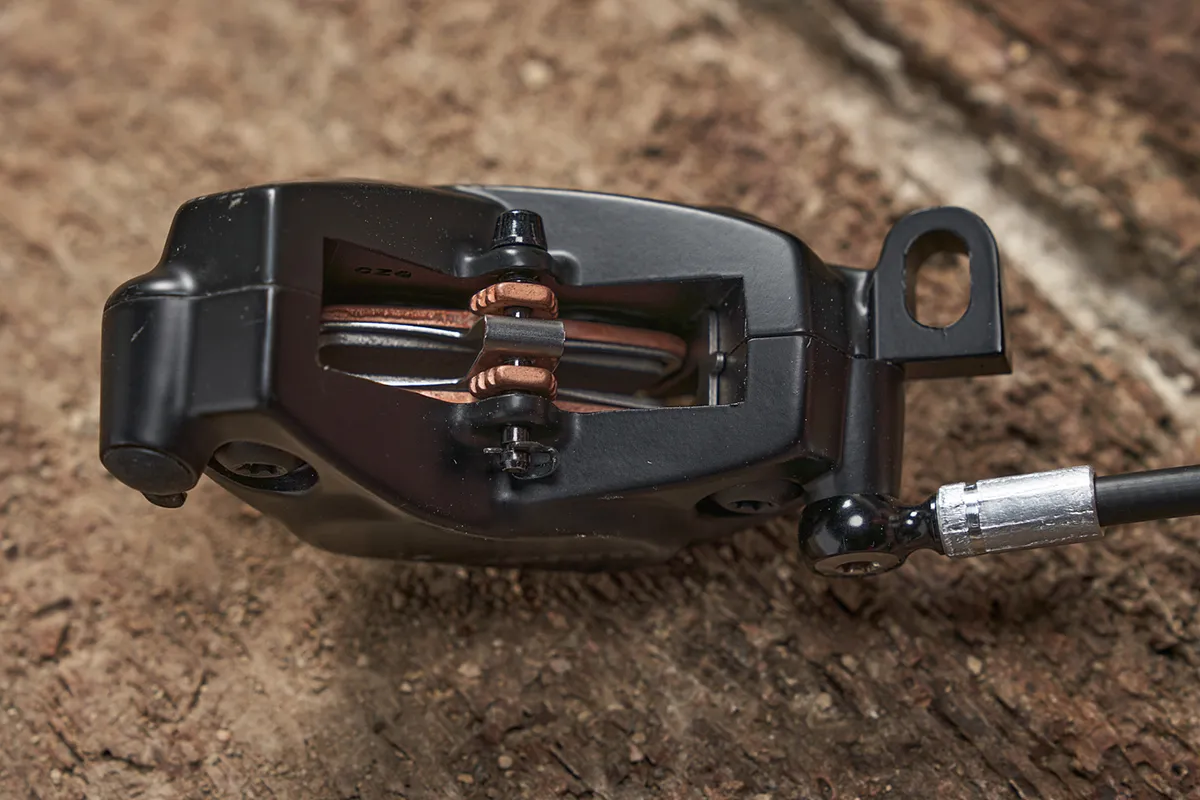
If pads are removable from the top of the caliper, they can be cleaned or replaced without the hassle of removing the wheel first. You don’t have to do this often, but it’s handy and far easier when you do.
Brake fluid

Hydraulic brakes use mineral oil or DOT fluid to drive their pistons. DOT fluid is bad for skin and paintwork, and needs more careful handling than mineral oil, but deals with water absorption better. Both are effective, but they need to be changed on a regular basis for best performance.
If you're looking to get your disc brakes back to their best performance, we also have guides on how to bleed Shimano disc brakes, how to bleed SRAM disc brakes and how to bleed Hope disc brakes.
